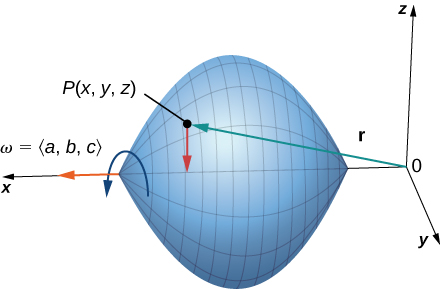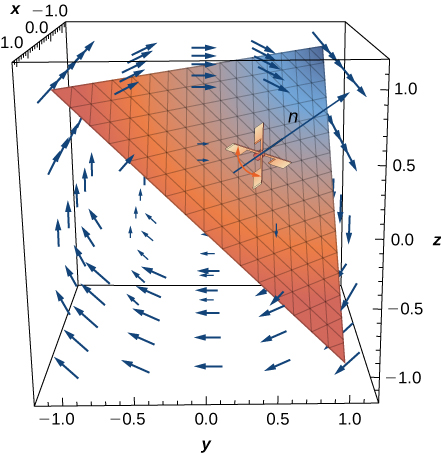15.5E: Divergence and Curl (Exercises)
- Last updated
- Jan 25, 2020
- Save as PDF
- Page ID
- 35139
( \newcommand{\kernel}{\mathrm{null}\,}\)
For the following exercises, determine whether the statement is True or False.
1. If the coordinate functions of ⇀F:R3→R3 have continuous second partial derivatives, then curl(div⇀F) equals zero.
2. ⇀∇⋅(xˆi+yˆj+zˆk)=1.
- Answer
- False
3. All vector fields of the form ⇀F(x,y,z)=f(x)ˆi+g(y)ˆj+h(z)ˆk are conservative.
4. If curl⇀F=⇀0, then ⇀F is conservative.
- Answer
- True
5. If ⇀F is a constant vector field then div⇀F=0.
6. If ⇀F is a constant vector field then curl⇀F=⇀0.
- Answer
- True
For the following exercises, find the curl of ⇀F.
7. ⇀F(x,y,z)=xy2z4ˆi+(2x2y+z)ˆj+y3z2ˆk
8. ⇀F(x,y,z)=x2zˆi+y2xˆj+(y+2z)ˆk
- Answer
- curl⇀F=ˆi+x2ˆj+y2ˆk
9. ⇀F(x,y,z)=3xyz2ˆi+y2sinzˆj+xe2zˆk
10. ⇀F(x,y,z)=x2yzˆi+xy2zˆj+xyz2ˆk
- Answer
- curl⇀F=(xz2−xy2)ˆi+(x2y−yz2)ˆj+(y2z−x2z)ˆk
11. ⇀F(x,y,z)=(xcosy)ˆi+xy2ˆj
12. ⇀F(x,y,z)=(x−y)ˆi+(y−z)ˆj+(z−x)ˆk
- Answer
- curl ⇀F=ˆi+ˆj+ˆk
13. ⇀F(x,y,z)=xyzˆi+x2y2z2ˆj+y2z3ˆk
14. ⇀F(x,y,z)=xyˆi+yzˆj+xzˆk
- Answer
- curl ⇀F=−yˆi−zˆj−xˆk
15. ⇀F(x,y,z)=x2ˆi+y2ˆj+z2ˆk
16. ⇀F(x,y,z)=axˆi+byˆj+cˆk for constants a,b,c.
- Answer
- curl ⇀F=⇀0
For the following exercises, find the divergence of ⇀F.
17. ⇀F(x,y,z)=x2zˆi+y2xˆj+(y+2z)ˆk
18. ⇀F(x,y,z)=3xyz2ˆi+y2sinzˆj+xe2zˆk
- Answer
- div⇀F=3yz2+2ysinz+2xe2z
19. ⇀F(x,y)=(sinx)ˆi+(cosy)ˆj
20. ⇀F(x,y,z)=x2ˆi+y2ˆj+z2ˆk
- Answer
- div⇀F=2(x+y+z)
21. ⇀F(x,y,z)=(x−y)ˆi+(y−z)ˆj+(z−x)ˆk
22. ⇀F(x,y)=x√x2+y2ˆi+y√x2+y2ˆj
- Answer
- div⇀F=1√x2+y2
23. ⇀F(x,y)=xˆi−yˆj
24. ⇀F(x,y,z)=axˆi+byˆj+cˆk for constants a,b,c.
- Answer
- div⇀F=a+b
25. ⇀F(x,y,z)=xyzˆi+x2y2z2ˆj+y2z3ˆk
26. ⇀F(x,y,z)=xyˆi+yzˆj+xzˆk
- Answer
- div⇀F=x+y+z
For exercises 27 & 28, determine whether each of the given scalar functions is harmonic.
27. u(x,y,z)=e−x(cosy−siny)
28. w(x,y,z)=(x2+y2+z2)−1/2
- Answer
- Harmonic
29. If ⇀F(x,y,z)=2ˆi+2xj+3yk and ⇀G(x,y,z)=xˆi−yˆj+zˆk, find curl(⇀F×⇀G).
30. If ⇀F(x,y,z)=2ˆi+2xj+3yk and ⇀G(x,y,z)=xˆi−yˆj+zˆk, find div(⇀F×⇀G).
- Answer
- div(⇀F×⇀G)=2z+3x
31. Find div⇀F, given that ⇀F=⇀∇f, where f(x,y,z)=xy3z2.
32. Find the divergence of ⇀F for vector field ⇀F(x,y,z)=(y2+z2)(x+y)ˆi+(z2+x2)(y+z)ˆj+(x2+y2)(z+x)ˆk.
- Answer
- div⇀F=2r2
33. Find the divergence of ⇀F for vector field ⇀F(x,y,z)=f1(y,z)ˆi+f2(x,z)ˆj+f3(x,y)ˆk.
For exercises 34 - 36, use r=|⇀r| and ⇀r(x,y,z)=⟨x,y,z⟩.
34. Find the curl⇀r
- Answer
- curl⇀r=⇀0
35. Find the curl⇀rr.
36. Find the curl⇀rr3.
- Answer
- curl⇀rr3=⇀0
37. Let ⇀F(x,y)=−yˆi+xˆjx2+y2, where ⇀F is defined on {(x,y)∈R|(x,y)≠(0,0)}. Find curl⇀F.
For the following exercises, use a computer algebra system to find the curl of the given vector fields.
38. [T] ⇀F(x,y,z)=arctan(xy)ˆi+ln√x2+y2ˆj+ˆk
- Answer
- curl ⇀F=2xx2+y2ˆk
39. [T] ⇀F(x,y,z)=sin(x−y)ˆi+sin(y−z)ˆj+sin(z−x)ˆk
For the following exercises, find the divergence of ⇀F at the given point.
40. ⇀F(x,y,z)=ˆi+ˆj+ˆk at (2,−1,3)
- Answer
- div⇀F=0
41. ⇀F(x,y,z)=xyzˆi+yˆj+zˆk at (1,2,3)
42. ⇀F(x,y,z)=e−xyˆi+exzˆj+eyzˆk at (3,2,0)
- Answer
- div⇀F=2−2e−6
43. ⇀F(x,y,z)=xyzˆi+yˆj+zˆk at (1,2,1)
44. ⇀F(x,y,z)=exsinyˆi−excosyˆj at (0,0,3)
- Answer
- div⇀F=0
For exercises 45- 49, find the curl of ⇀F at the given point.
45. ⇀F(x,y,z)=ˆi+ˆj+ˆk at (2,−1,3)
46. ⇀F(x,y,z)=xyzˆi+yˆj+xˆk at (1,2,3)
- Answer
- curl ⇀F=ˆj−3ˆk
47. ⇀F(x,y,z)=e−xyˆi+exzˆj+eyzˆk at (3,2,0)
48. ⇀F(x,y,z)=xyzˆi+yˆj+zˆk at (1,2,1)
- Answer
- curl ⇀F=2ˆj−ˆk
49. ⇀F(x,y,z)=exsinyˆi−excosyˆj at (0,0,3)
50. Let ⇀F(x,y,z)=(3x2y+az)ˆi+x3ˆj+(3x+3z2)ˆk. For what value of a is ⇀F conservative?
- Answer
- a=3
51. Given vector field ⇀F(x,y)=1x2+y2⟨−y,x⟩ on domain D=R2{(0,0)}={(x,y)∈R2|(x,y)≠(0,0)}, is ⇀F conservative?
52. Given vector field ⇀F(x,y)=1x2+y2⟨x,y⟩ on domain D=R2{(0,0)}, is ⇀F conservative?
- Answer
- ⇀F is conservative.
53. Find the work done by force field ⇀F(x,y)=e−yˆi−xe−yˆj in moving an object fromP(0,1) to Q(2,0). Is the force field conservative?
54. Compute divergence ⇀F(x,y,z)=(sinhx)ˆi+(coshy)ˆj−xyzˆk.
- Answer
- div⇀F=coshx+sinhy−xy
55. Compute curl ⇀F=(sinhx)ˆi+(coshy)ˆj−xyzˆk.
For the following exercises, consider a rigid body that is rotating about the x-axis counterclockwise with constant angular velocity ⇀ω=⟨a,b,c⟩. If P is a point in the body located at ⇀r=xˆi+yˆj+zˆk, the velocity at P is given by vector field ⇀F=⇀ω×⇀r.

56. Express ⇀F in terms of ˆi,ˆj, and ˆk vectors.
- Answer
- ⇀F=(bz−cy)ˆi+(cx−az)ˆj+(ay−bx)ˆk
57. Find divF.
58. Find curlF
- Answer
- curl ⇀F=2⇀ω
In the following exercises, suppose that ⇀∇⋅⇀F=0 and ⇀∇⋅⇀G=0.
59. Does ⇀F+⇀G necessarily have zero divergence?
60. Does ⇀F×⇀G necessarily have zero divergence?
- Answer
- ⇀F×⇀G does not have zero divergence.
In the following exercises, suppose a solid object in R3 has a temperature distribution given by T(x,y,z). The heat flow vector field in the object is ⇀F=−k⇀∇T, where k>0 is a property of the material. The heat flow vector points in the direction opposite to that of the gradient, which is the direction of greatest temperature decrease. The divergence of the heat flow vector is ⇀∇⋅⇀F=−k⇀∇⋅⇀∇T=−k⇀∇2T.
61. Compute the heat flow vector field.
62. Compute the divergence.
- Answer
- ⇀∇⋅⇀F=−200k[1+2(x2+y2+z2)]e−x2+y2+z2
63. [T] Consider rotational velocity field ⇀v=⟨0,10z,−10y⟩. If a paddlewheel is placed in plane x+y+z=1 with its axis normal to this plane, using a computer algebra system, calculate how fast the paddlewheel spins in revolutions per unit time.

Contributors
Gilbert Strang (MIT) and Edwin “Jed” Herman (Harvey Mudd) with many contributing authors. This content by OpenStax is licensed with a CC-BY-SA-NC 4.0 license. Download for free at http://cnx.org.


